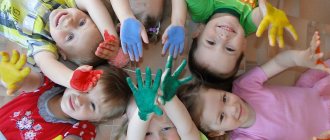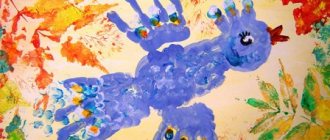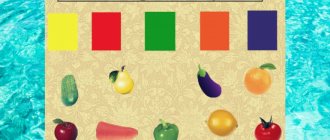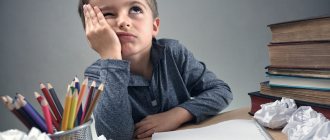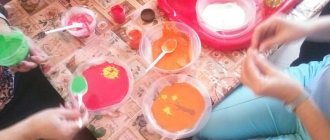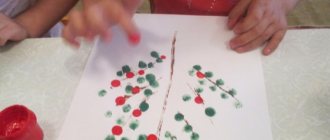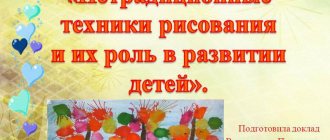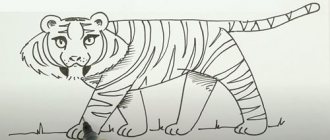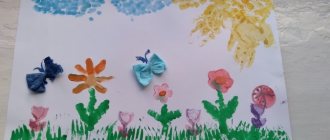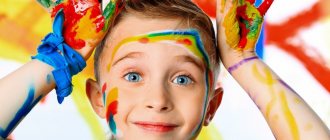What is the essence of non-traditional drawing for children 4–5 years old?
Non-traditional drawing is a method of visual activity that is not based on the traditions of this type of creativity in terms of the choice of materials for applying paint, but uses cotton swabs, fingers, foam rubber, crumpled paper, etc.
In kindergarten, non-traditional drawing is notable for the fact that all (!) kids get different pictures. For children in the middle group, these techniques of visual creativity, first of all, stimulate the development of research abilities, as they open up wide scope for experiments: applying dyes to materials of natural origin, drawing through gauze, etc. In addition, non-traditional drawing:
- trains sensorimotor coordination and fine motor skills, which is a key factor in speech development;
- develops memory, attention;
- promotes the development of imaginative thinking;
- forms the prerequisites for harmonious social and communicative development - children in the process of work turn to each other and to adults, ask questions;
- develops aesthetic taste and ideas about harmony.
Non-traditional drawing in individual classes, as well as as a type of work in lessons of various educational areas in preschool educational institutions, helps solve the following problems:
- expand children's understanding of ways to depict objects;
- develop interest in teamwork;
- practice working with different materials - to realize a creative idea, children draw using cotton wool, palms, stamps, etc.;
- activate children's creative abilities and imagination;
- create an emotionally positive climate in the team (the children’s work looks like a game - to make the lawn more beautiful, they draw dandelions with a poke of a cotton swab, and using their fingers to depict raindrops, they say: “Rain, rain, drip-drip-drip”);
- develop self-confidence.
Non-traditional drawing classes create an atmosphere of goodwill in the team
Short-term project in kindergarten in the middle group. Unconventional drawing techniques
Short-term project in the middle group on the topic: “Young artists” (non-traditional drawing techniques)
Project type: creative. Deadline: from January 9, 2022 academic year. until January 30, 2022 academic year. d. Age of children: 4-5 years Relevance of the topic - Formation of a creative personality, its most complete disclosure is the most important task of pedagogy at the present stage. An effective means of solving it in preschool childhood is visual creativity, including with the help of non-traditional techniques, methods and forms of its organization. Practice shows: non-traditional artistic techniques are an effective means of preschoolers mastering patterns of composition and color and can ensure the development of children's visual creativity in general. Creativity is a prerequisite for the comprehensive development of a child; it makes him richer, more joyful, awakens his imagination, teaches him to dream, to come up with something new and yet unknown. In the process of creativity, the child develops intellectually and emotionally, determines his attitude to life and his place in it, expresses himself and his feelings, gains experience in relationships, improves skills in working with various tools and materials. By drawing, a child forms and develops certain abilities: visual assessment of shape, orientation in space, sense of color. Special skills and abilities are also developed: eye-hand coordination. Project goal : 1. Development of children's creative abilities, imagination, imagination through non-traditional drawing. 2. Identification and development of creative abilities in children of the middle group through entertaining painting activities. Objectives: 1. Develop ways to develop creative abilities in the field of drawing with painting materials. 2. Test non-traditional drawing techniques to develop the creative abilities of children of middle preschool age. 3. Teach children to choose a material for non-traditional drawing and skillfully use it. 4. Help children master various technical skills when working with non-traditional techniques. 5. Instill interest in drawing using non-traditional techniques. 6. Develop creativity and imagination. 7. Develop a sense of collectivism, camaraderie, the desire to come to the aid of each other. 8. Teach to empathize with the mood conveyed in the drawing. Project participants: Children of the Smeshariki secondary group, teachers, parents. Expected result: 1. Increase the dynamics of a high level of development in fine arts. 2. The ability to apply learned techniques in activities. 3. Promote the self-realization of the child’s personality in artistic creativity, stimulate the desire to be original in the choice of means of one’s design, and evaluate the products of one’s own and others’ activities. 4. Creation of a children's album of drawings “Young Artists”. Non-traditional drawing techniques: Poking with a hard semi-dry brush, finger painting, watercolor, regular blotography, drawing with plasticine, drawing candles, drawing with foam on a stick. Methods and techniques for teaching non-traditional drawing: 1. Creating a game situation. 2. Demonstration by the teacher. 3. Using hand movements. 4. Speaking the sequence. 5. Pedagogical diagnostics. 6. When drawing with non-traditional techniques, poems, riddles, and games are widely used. Methodological recommendations: When organizing classes in non-traditional drawing, it is important to remember that in order for children to master skills and abilities, it is necessary to take into account the age and individual characteristics of preschoolers, their desires and interests. As the child ages, the content expands, the elements and the shape of the paper become more complex, and new means of expression are identified. Technical equipment: - sheets of paper - gouache - short-hair brushes - cotton swabs - foam rubber - candles - fluorescent plasticine for drawing - sheets with coloring pages of cartoon characters. “Smeshariki”, etc. Stages of the project: Stage 1 - preparatory:
- Create a developmental environment and the appropriate material base - study of literature - selection of material (theoretical justification, development of consultation for parents) - drawing up a long-term plan - finding and establishing effective connections with parents.
Stage 2 - main:
1. Develop artistic and creative abilities in children of middle preschool age with the help of non-traditional techniques and painting materials through a system of classes.
2. During classes, the following methods and techniques are used: conversation, demonstration of techniques, explanation, instructions, reminders, encouragement, analysis, game methods. 3. Non-traditional equipment, illustrative material, and music are used in classes. 4. In drawing classes, introduce children to the techniques of drawing with cotton swabs, drawing candles, drawing with plasticine, and painting with stained glass paints. Learn to use various materials in drawing: cotton swabs, candles. Stage 3 - work with the parent:
1. Conversations with parents.
2. Consultations for parents. 3. Designing a corner for parents on this topic. 4. Exhibition (collective works of children). 5. Replenishing the corners for visual arts with non-traditional drawing materials (toothbrushes, cotton swabs, threads, candles, corks, etc.). Stage 4 - final:
1. Identify the level of artistic and creative abilities of children, developed during classes with non-traditional techniques and painting materials.
2. Design of the children's album “Young Artists”. 3. Exhibition of works. Action plan for the implementation of the project Topic Contents of the work Dates Conversation on the topic: “Who are the artists?” Introduce children to the profession of an artist, the significance of his activities for society, and the tools of his work. Looking at illustrations. January 9 Consultation for parents “Use of non-traditional drawing methods.” Instill interest in the family in drawing using non-traditional techniques. January 10 “Christmas tree in the snow” Arouse interest in drawing in an unconventional way. We consolidate the technique of non-traditional drawing (we draw with our fingers) January 12 “Frosty pattern” Learn to draw patterns of candles, paint over patterns on a dark background of paper with white paint. January 15 “Two halves” (regular blotography) Introduce a new technique - regular blotography. Teach children to create, to enjoy the beauty of this action. Develop imagination and fantasy in a child. January 17 Didactic game: “Artists restorers.” To develop children's creative imagination, the ability to compose a winter landscape from parts according to a model. January 19 “I see - I finish drawing” To develop children's creative imagination. January 23 “Bullfinch Bird” Teach techniques for using plasticine painting techniques. January 25 Examination of paintings: A. Plastov “First Snow”. Evoke an emotional response to the artistic image of a winter landscape; develop artistic perception of landscape paintings. January 29 Design of the children's album “Young Artists”. Exhibition of works. Collaboration between teacher and children. January 30 Project result: During the project, children were very attracted to non-traditional materials; the more diverse the art materials, the more interesting it was to work with them. Therefore, introducing preschoolers to non-traditional drawing techniques made it possible not only to increase children’s interest in visual arts, but also contributed to the development of creative imagination. During our project, children together with adults did a lot, namely: - An album with drawings “Young Artists” was made. - Consultations for parents, folders for moving on “Non-traditional drawing” were prepared: Literature: 1. Davydov G. N. Non-traditional drawing techniques in kindergarten Part 1.-M.
: "Publishing house Scriptorium 2003", 2007. 2. Davydov G. N. Non-traditional drawing techniques in kindergarten. Part 2. - M.: "Scriptorium Publishing House 2003", 2007. 3. Nikitina A.V. Non-traditional drawing techniques in kindergarten. Planning, lesson notes. Manuals for educators and interested parents. -SPb. : KARO, 2008 4. Utrobina K.K., Utrobin R.F. Fun drawing using the poking method with children 3-7 years old. -M. : GNOM and D, 2004. 5. Fateeva A. A. Drawing without a brush. — Yaroslavl: Academy of Development: Academy Holding, 2004. 6. Kazakova R. T. Drawing classes with preschoolers - M.: TC “Sfera”, 2008. 7. Komarova T. S. Teaching preschoolers drawing techniques. - M.: Pedagogical Society of Russia, 2005. 8. Ruzanova Yu. V. Development of motor skills in preschoolers with non-traditional visual activities. - St. Petersburg. : KARO, 2007. Download Short-term project in the middle group on the topic “Young Artists” (non-traditional drawing techniques)
We recommend watching:
Unconventional drawing technique pointillism
Drawing lesson in the middle group of kindergarten Drawing with a candle in kindergarten
Drawing on sandpaper
Similar articles:
Fine arts lesson for the senior group
Monotype in kindergarten
Non-traditional drawing techniques in preschool educational institutions
Non-traditional drawing technique in kindergarten. Passepartout
Wax painting in kindergarten
Techniques and methods of non-traditional drawing for middle preschool age
Children 4–5 years old use non-classical drawing techniques to practice skills acquired in regular lessons:
- sketch the boundaries of the image with a pencil or paints;
- think over decorations - confetti, plasticine, beads, etc.;
- complete the missing elements, for example, multi-colored blots need to be combined into one form using lines made with pencils or paints;
- paint over the background (if, for example, a drawing of forest trees was created using the monotype technique, the background and sky need to be drawn separately).
Finger painting (fingergraphy)
Tactile sensations are, along with visual impressions, the leading way of understanding objects and phenomena around us. Therefore, special attention is paid to fingergraphy in kindergarten. But if in the younger groups children made dotted strokes, for example, painted peas on an umbrella, then in the middle group the children learn to draw lines, spots of different sizes, strokes, and also paint over certain elements of the drawing.
At the beginning of the year, children in the middle group repeat making dots with their fingers and train the skill of making round elements
In the middle group, the practice of finger drawing according to a pattern is introduced. The teacher tells, shows and hangs up an algorithm of actions on the board, how to draw an animal or a person using prints and dots-squiggles made with a pencil.
Schemes of step-by-step finger painting are presented in the book by I. Molnar “Imprint, dot, stroke. We paint with our fingers."
For fingerprinting, gouache is usually used, since it does not require dilution with water, is thick and produces bright shades. However, you can also use special hypoallergenic paints for finger painting, as well as watercolors. When working with the latter, before dipping your finger into the paint, you need to moisten it with water or drop some water into a container with watercolors.
Finger painting technique
The sequence of work in the fingergraphy technique is as follows:
- Dip your finger into the paint can.
- Using each finger we pick up paints of different shades. Remove excess with a damp cloth.
- Using your fingertips, apply the design to the sheet.
- After finishing work, wash your hands with soap.
In addition to berries and leaves, kids can also use their fingers to draw lines to depict branches.
Palm painting
As with finger painting, palm painting involves creating an imprint and adding to it using brushes. In the middle group, the imprint becomes the basis for creating various objects: birds, foliage, fish, etc. In addition, with your palms you can create elements such as leaves on trees, flowers in a vase, hedgehog needles, etc.
Palm drawing technique
For palm painting, the drawing algorithm will be as follows:
- Place your palm in a saucer of paint. In the second semester, children learn to create multi-colored prints with one hand, so the paint will be applied with a brush held in their free hand. The skill of such multi-colored prints is developed in lessons on the topic “Bullfinch”, “Butterfly”, etc.
- Press your palm firmly against the sheet, and if necessary, slightly rotate it in a circle, horizontally or vertically.
- After finishing work, wash your hands with soap.
Drawing birds with their palms, the children add details made with a brush - beak, legs
Combined technique: fingergraphy and palm painting
For some topics, a combination of drawing with palms and fingers will be relevant. For example, for the drawings “Funny Octopuses”, “Fish”, etc., the main detail, that is, the body, is done with the palm of the hand, and the eyes and scales are drawn with the fingers.
The combined technique allows you to develop the ability to find the center of the image, mix colors and shades to obtain the required tone, which helps to more accurately convey the idea.
To depict a hedgehog, first draw the body using your palms, and then use your fingers to fill in the grass, nose and eye.
Poking drawing
This technique is indispensable when creating “fluffy” or “spiky” images. Needles on a hedgehog, fur on a kitten, Christmas trees, dandelions - all these images acquire a special flavor thanks to the poking technique.
Poking technique
To create a poke:
- Place a dry brush with stiff bristles into a jar of gouache.
- Holding the brush vertically, we make a sharp blow to the paper.
- Rinse the brush and blot with a napkin.
The poke can only be done with a dry or semi-dry brush.
In the drawing with a poke, very natural shade transitions are obtained.
Monotype
This unconventional technique involves creating a picture by imprinting part of the design on the blank half of a folded sheet. At the age of 4–5, through monotype, children begin to master landscapes, which they will work with in older groups, train the ability to find the middle of an object, and develop the skill of seeing symmetry.
At the same time, not only symmetrical, but also paired objects are created in this way. To do this, a whole image is drawn on one half of the sheet, which is also completely printed on the second side.
Monotype technique
To create a monotype image:
- We bend the sheet in the middle - vertically or horizontally, depending on the location of the depicted object.
- Unbend and draw a picture on one half.
- We bend the sheet again and iron it with our hands.
- We expand and supplement the resulting image with the necessary elements. For example, let’s make a blue background for a river in which a forest is displayed.
In the drawing of a forest reflected in a lake, after unfolding the sheet, children draw a green strip of grass
Toothbrush painting technique
To obtain voluminous, multi-layered designs, a toothbrush is used. Having collected the paint, we brush it across the sheet, focusing on the design.
In the middle group, drawing with a toothbrush is usually combined with the use of the poking method, appliqué or drawing with cotton swabs.
Toothbrush drawings in the middle group are usually made on a colored background
Spray
The essence of the technique is that kids pick up paint with a brush or comb, and, pointing it at the sheet, run a pencil along the bristles, thus painting the space of the drawing.
To create a one-color image from several elements, stencils are applied simultaneously
In the middle group, children become familiar with the concepts of foreground and background. For this, the multilayer spray method, which involves the use of stencils, will be an indispensable assistant.
Methodology for working with multi-layer spraying
To make a multi-layer spray:
- We attach the stencil to the sheet using paper clips.
- Take the paint with a brush.
- Let's spray.
- Apply another stencil.
- Spray a different color.
- We remove the stencils - the image turned out to be voluminous and multifaceted.
For multi-layer spraying, you can use stencils of the same image, but of different sizes, then you will get a flickering effect
Video: master class on painting with spray paint
Drawing with foam rubber
To highlight the texture of the depicted object - clusters of flowers, curly clouds - the method of applying paint with foam rubber (or a piece of sponge) is used. To prevent the sponge from getting your hands dirty, it is clamped with a clothespin that acts as a handle.
At the beginning of mastering the technique of drawing with foam rubber, children use stencils
Stamping technique using natural materials
A whole vegetable (onion, corn, potato, cucumber, etc.) or fruit, berry (apple, lemon, feijoa, etc.), cut in half, flowers (daisies), shells, is painted and an imprint is created on paper. This technique is convenient for drawing cross-sections of fruits and vegetables. For example, to create the composition “Grandma’s Compote,” kids draw the outlines of a pan with a pencil, and depict fruits with stamps.
Photo gallery: drawings with different stamps in the middle group
To depict balloons, it is convenient to use stamps with small balls
To depict a picture of falling leaves, children use stamps from autumn leaves collected on a walk
To prevent the vegetable salad from stamps from being “blurred”, you need to dry the imprint of each “vegetable”
Video: master class on drawing with stamps from natural materials
Drawing with a fork and crumpled paper
Another type of stamp is creating pictures with a fork or crumpled paper. Using a metal or plastic fork, scoop up paint from a bowl and make an imprint on paper.
To make the image brighter, you need to apply a thick layer of paint
Carefully lower a crumpled piece of paper into the paint and use it to leave a mark on the sheet.
To make the elements more naturalistic, the pieces of paper should be of different sizes
In the middle group, both methods are complicated by the addition of other isotechniques: appliqué or plasticineography, as well as the classical method of drawing.
Video: master class on drawing snowflakes with crumpled paper using masking tape
Drawings with cotton swabs or cotton pads
If at 1.5–4 years old children decorated images with dots of paint made with cotton swabs, then in the middle group the task becomes more complicated. The children learn to draw lines, geometric shapes, etc. on a blank sheet of paper with cotton swabs, relying only on their ideas.
Cotton pads for use in painting are folded in half or several times, dipped in paint and applied to the sheet.
Photo gallery: examples of drawings with cotton swabs in the middle group
Initially, children use cotton swabs to color the picture.
On the “fish”, kids practice the technique of making lines and dots of different sizes and thicknesses
« » « » « » » « “Vegetable salad” children try to draw with cotton swabs without drawing pencil outlines
Blotography
The essence of the technique is to obtain pictures based on spots and blots. Spots can either be used to decorate a design as intended, or can be used as a basis for an image in a traditional style.
Blotography technique
To create blots:
- Dip the wet brush into the paint.
- Make a stain or place a drop.
- Blow from a cocktail straw onto the paint, blowing it in the desired direction.
In the middle group, kids learn to inflate thin elements from a spot, for example, tree branches
Video: master class on drawing using blotography
Nitcography
To depict a sheep, a fluffy dog or a cloud, you can use a thread drawing: apply paint to a woolen thread, place it on a sheet, if necessary, perform circular movements.
In the middle group, the nitcography technique is used mainly for children to explore the possibilities of color combinations
Drawing with glue and semolina
We mark the indicated contours of the drawing with glue, pour in semolina and press it on top with a clean sheet. Remove the top sheet and shake off the remaining cereal. The elements are filled in one by one.
In the middle group, with this type of drawing, kids practice the ability to outline a stencil and apply glue exactly within the boundaries of the image.
The substrate for drawing semolina should be colored, since the grain will be invisible against a white background.
Drawing with semolina is the most accessible way to get a three-dimensional image
Wax painting
In the middle group, kids draw lines, spots and simple geometric shapes with a candle.
Wax painting technique
To create a candle design:
- We draw the outlines of the design on a white sheet with a candle.
- Paint the sheet with any colors.
- The wax lines remain unpainted and appear on the substrate.
Drawing with a wax candle is usually used in winter-themed lessons.
A variation of this technique is drawing with wax crayons. The process technology will be the same, but the wax pencils are multi-colored, so the drawings after filling with paint will be brighter.
For painting with wax, it is better to take watercolor paper, since children may not calculate the degree of moisture in the brush, and the sheet may break through.
Scratch
The technique involves scratching image lines on a paper substrate coated with paint according to a pattern previously applied with wax crayons.
Grattage technique
The procedure for creating a grattage drawing will be as follows:
- Color the drawing with wax crayons.
- Fill the surface of the sheet with black paint or ink.
- Leave to dry.
- Using a stick with a sharp end (for example, a wooden kebab skewer), we scratch the lines to reveal the design.
Children like the scratch paper because it contains a surprise element.
Drawing through gauze
Drawing through wet gauze does not require the use of unusual tools; the picture is created with a brush and paints.
Technique for drawing through gauze
To create a drawing using the original technique:
- We moisten the sheet with pieces of wet cotton wool or cotton pads.
- Place gauze on the paper and straighten it well.
- We create the drawing as usual.
- Let it dry, remove the gauze - the image becomes textured.
When painting through gauze, you need to apply the paint generously, as some of the “color” will disappear after removing the fabric.
Video: master class on drawing through gauze
What techniques are used
Modern methodology contributes to the implementation of the educational task when performing work.
Note! A similar technique is considered for children from 3 to 4 years old. In addition, you can organize additional interesting activities with minimal financial costs.
What technique is used in practice?
Drawing with cotton swabs
An unusual drawing technique develops a sense of rhythm and color. Cotton swab (stick) - a popular drawing technique is called the “poking method”. When creating a drawing, it is impossible to do without a cotton swab, container, and wet wipes. When creating a new material, little artists place a stick in a container of paint, and then apply imprints to the drawing.
How to teach your child mental math on your own
Important! Young artists can depict a river, rainbow, grass, rain, snow, sun, tree, sky or something else.
When creating a drawing using a cotton swab on the theme “Trees when autumn comes,” the teacher must show the children how to properly hold this object in their hands.
Instructions: Children receive blanks of tree trunks with branches, cotton swabs, and paints.
Important! To make it easier for the children, you can mark the area of the drawing, indicating the exact location of the foliage.
Finger painting
To implement this method, you can do without certain material. For example, a teacher prepares paint in advance with wet wipes.
Note! Implementing teamwork based on this technique is a great idea for both educators and preschoolers.
The teacher takes into account the mental and physical characteristics of the children and prepares a topic for drawing in advance, for example, “Foliage of autumn trees.” The teacher provides the little artists with a template - a large tree.
Other themes are also covered, such as “Winter” or “Summer is Coming.” In kindergartens, the finger painting “Snowflake” is most often created. To perform it, paints and pencils are used.
Instructions: The teacher distributes A4 sheets. The guys must draw a snowflake. To complete the work you will need a blue and white pencil.
Drawing with palms
This method is not the most accurate, since children must draw with their palms. Before creating a drawing, the teacher must prepare a shallow container of paint. Pour some water inside and drip some gouache.
Note! Using this method, you can easily create collective drawings, for example, “Fish in the Aquarium”, “Our Aquarium”, “Merry Matryoshka”, “Firebird”, “Winter has come”.
Instructions: The teacher shows the children the finished substrate. The drawing is created on a sheet with a blue background. The guys must completely dip their palm into the container of paint. Then the teacher calls on the kids to go to the table where the aquarium is located, stand in a circle and leave their imprint there with their thumb up or to the side.
There is no need to put a mark on the one that the first comrade has already put. The teacher also warns that the fish must be located at a certain distance from each other. Then make an eye for your fish using white paint. Dip your index finger into black paint, make a pupil and carefully draw a line near the mouth.
Drawing with soap bubbles
This technique is the most difficult. Here children will have to show their imagination (open mind). Before starting to draw with soap bubbles using the preschool method, the teacher prepares material in the form of liquid soap, baby shampoo, water, watercolors (food coloring), cocktail tubes, and spoons.
Lesson on FEMP and parental consultations in preparatory groups
Initially, the teacher prepares the mixture, and then pours the mixture equally into small glasses. You can prepare the paint by diluting soap with water (the ratio should be 10:1). After obtaining the mass, the addition of dye and a little gelatin or glycerin is required. Thanks to these components, the bubbles retain their shape for a long time. The finished mixture will have to be placed in a cool place (away from the sun) and kept for 2 days.
Important! It is recommended to strain the mass through cheesecloth. The finished mixture should be placed in the refrigerator for 10 hours. Having received the material, you can make a outlined and regular print.
Instructions: The teacher invites the children to take a sheet of paper, a container with soap solution, straws and disposable teaspoons. Children must blow into the tubes to create foam. Next, a mass of one color is collected and laid out on a sheet. The balls should be placed far from each other. Once the shape of each print is dry, children can add a string to each ball.
Drawing with stamps
Drawing with stamps can reveal the possibilities of using familiar objects as art material. This method promotes the mental development of the child.
Note! When drawing with a stamp, a child develops an interest in inventive art, which leads to increased self-esteem and the development of coordination of movements.
Foam rubber impression
The main goal of this method is to introduce students to an unconventional method of drawing using the “foam rubber imprint” technique, and to develop the ability to arrange the elements of a drawing on a sheet of paper.
Educational qualities: fosters a love of fine arts and nature.
Developmental qualities: to develop aesthetic perception, a creative attitude to work, attention, memory, spatial thinking, fine motor skills of the hands, a sense of composition, color, color perception, to form in children a stable interest in visual arts, creative imagination.
Methodology for preparing a lesson in drawing in non-traditional techniques
As a separate artistic and aesthetic direction, one lesson per week is devoted to drawing in the middle group according to the Federal State Standard (FSES). Its duration is 20 minutes. The teacher chooses the drawing technique - traditional or non-traditional - based on the topic of the lesson and the level of preparation of the children. The structure of the lesson will be the same as in other areas of education.
Conducting non-traditional drawing classes requires careful planning
Table: timing and essence of the stages of a non-traditional drawing lesson
| Stage | Time | Content |
| Introductory | up to 3 minutes | The teacher introduces the kids to the topic of the lesson, updates their knowledge with the help of riddles, poems, fairy tales (cartoons). |
| Basic | explanation - up to 4 minutes | The teacher shows a sample drawing and demonstrates the procedure for completing a creative task. Before starting drawing, finger gymnastics, finger gymnastics and/or physical education are performed. |
| practical activity - up to 10 minutes | Children draw, the teacher provides individual assistance if necessary. | |
| Final | up to 3 minutes | The teacher organizes an exhibition of children's drawings and praises the children for their work. Children try to evaluate their pictures according to the criteria “it worked/didn’t work”, “like the picture/don’t like it and why.” The teacher points out the shortcomings in general; the shortcomings of each are discussed individually. |
Table: Karpova I.N. Summary of a lesson on unconventional drawing on the theme “Sun” in the middle group
| Stage | The essence |
| Introductory | - Today we will find ourselves in the world of a fairy tale. So sit back and get ready to listen. Today is a holiday in the magical kingdom of colors. In winter, the Sun rarely appeared in the sky. And now spring has come. The sun spent a long time preparing for this celebration, trying on her outfits. His wardrobe included outfits in yellow and orange shades. These colors are called warm. And the harmful crocodile decided to ruin the holiday - he swallowed our sun. Everyone loved the sun and rejoiced when it appeared in the sky, but no one loved the crocodile. And he decided to swallow the Sun. Everything around has faded, turned gray and dull. Without the sun it became somehow quite sad. But this is a fairy tale. And who saves the sun in it? Bear, but in winter and early spring the bear is still sleeping, and asked you and me to help the sun. By the way, the crocodile also took your tassels. What are we going to draw with? Hands, palms. |
| Basic | - But first you need to stretch your fingers. (Gymnastics for fingers) Here are my fingers, like the rays of the sun. One, two, three, four, five - Let's count the rays. (We bend the fingers on 2 hands at the same time) A clear morning will come. The red sun will rise. (Raise your arms above your head) Wake up kids, it’s time to save the Sun! |
| Independent work of children. Children sit in front of whatman paper (it’s convenient to work while standing), make an impression with their palm, using warm colors to the accompaniment of quiet, calm music. Children try to make the impression one by one, without jostling. (For convenience, the teacher can rotate the Whatman paper). - Guys, look, the crocodile has freed the sun! Look how we turned out. Bright, unusual, and warm. | |
| Final | “Everyone did well today, they tried to work together and no one bothered anyone.” You did everything together, that’s why it turned out so beautifully. |
| Source | https://nsportal.ru/detskiy-sad/risovanie/2014/02/26/konspekt-zanyatiya-po-netraditsionnomu-risovaniyu-rybki |
Video: finger painting lesson on the theme “Winter Forest” in the middle group
Video: sponge painting lesson on the theme “Autumn” in the middle group
Long-term planning for unconventional drawing
In order to distribute in advance the order of mastering non-traditional drawing techniques according to the topics of the educational process, the teacher draws up a long-term plan for this artistic and aesthetic direction. As a rule, two lessons per month are allocated to non-traditional techniques and two to traditional ones. Regardless of the technique, after the lesson there is an exhibition of children's work.
You can see an example of drawing up a long-term plan for non-traditional drawing as part of the educational process here. In addition, non-traditional drawing can be studied as part of a circle or organized as a project assignment.
Creative activities teach kids to be proud of the results of their work
Children are tireless seekers of new experiences and knowledge. The task of adults is to find the most suitable ways to make children believe in their strength and uniqueness. Fine arts, in particular unconventional drawing, provide invaluable assistance in this regard. After all, without the usual brushes and pencils, the child feels freer and can fully express his imagination.
